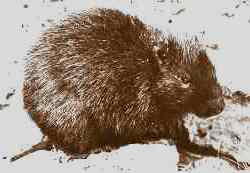| Cabrera's hutia | |
|---|---|
 | |
| Scientific classification | |
| Kingdom: | Animalia |
| Phylum: | Chordata |
| Class: | Mammalia |
| Order: | Rodentia |
| Family: | Echimyidae |
| Tribe: | Capromyini |
| Genus: | Mesocapromys |
| Species: | M. angelcabrerai |
| Binomial name | |
| Mesocapromys angelcabrerai (Varona, 1979) | |
 | |
| Red: native Green: introduced | |
Cabrera's hutia (Mesocapromys angelcabrerai) is a small, critically endangered, rat-like mammal found only in Cuba. It lives in communal shelters in swamps and coastal mangrove forests, and is threatened by habitat loss. [2] It is a member of the hutia subfamily (Capromyinae), a group of rodents native to the Caribbean that are mostly endangered or extinct.
Its species name, angelcabrerai, is in honour of Spanish zoologist Ángel Cabrera.
